My UPD8
You need to login before you download the free activities. You can register here.
- The Centre for Science Education
- The Association for Science Education
- Partners
- Part of ASE online
Scratch proof

Type: Activity
Learning Strategy: Information retrieval
Topic: Bonding & structure
Mobile phone screens can get badly scratched in pockets full of loose change, keys and combs. A tough plastic film, developed in Japan, is set to make scruffy screens a thing of the past. It shrugs off ink and metals don't scratch it.
So what gives the plastic its amazing toughness? In this DART activity, pupils learn how a solid's properties depend on the forces holding the particles together.
Published: 5th January 2005
Reviews & Comments: 5
Learning objectives
Learning objective
Pupils will associate hard materials with particles that are firmly held together and explain why some materials repel water.
Try the activity
- Teachers notes
Downloaded: 2582 times - Activity sheet
Downloaded: 4248 times
You will need Acrobat Reader installed to open the activity sheets.
Curriculum link
QCA Unit 7GPupils should be taught how the particle theory of matter can be used to explain the properties of solids.
Running the activity
Timing: starter - 5 minutes; main 10 minutes; plenary 5 minutes
Suggested starter activity: Introduce the activity by talking about how annoying it is when your shiny new phone gets its first scratch.
Main Activity: Project page 1, which shows an advert for a scratchproof mobile and sets the task. Pupils need to write a report on the phone for a magazine's advice page. They will have to refer to "the Science" on Page 2 to explain how its protective coating works. Page 2 explains in terms of particles why some materials are harder than others and shows what makes a surface repel water.
Page 3 is the template for the pupils report and shows the main components of the phone's scratch-free coating. It's key features are that it is non-stick, because of its plastic matrix, and hard because it has microscopic spheres of silica embedded in the plastic.
As a plenary the class could brainstorm to come up with a list of other applications of this tough, non-stick coat. It is already being used on DVDs and variations on the formula are being developed for other applications, like windows that don't need cleaning.
Web links
News links
- New Scientist
- Super-tough coating for cellphones and discs: A New Scientist article describing the breakthrough in creating a scratch resistant coating for DVDs and mobile screens.
- Armor Plated or Overrated?
- Armor Plated or Overrated? An illustrated account of an experiment to compare the abrasion resistance of ordinary DVDs and discs with scratch-resistant coatings.
- Hard materials
- Exploring the material world: An excellent introduction to what makes materials hard using diamond, graphite and Kevlar as examples.
Reviews & Comments
Write your online review to share your feedback and classroom tips with other teachers. How well does it work, how engaging is it, how did you use it, and how could it be improved?
Scatch Proof Activity
Jun 20th, 2010

used this as an extension task to develop ideas about the particle model past the usual s/l/g model - worked really well.
Reviewer: Chris Budd
Scratch proof review
Jul 15th, 2008

Excellent- used as a stimulus for extended writing, some excellent written outcomes.
Reviewer: Michael Corbett
Scratch proof review
Apr 6th, 2008

Haven't been able to use it yet but it's on standy by as it looks very promising
Reviewer: Gill Mulliss
Scratch proof, good for OCR National in Science!
Apr 26th, 2007

I have just used this activity with 2 groups of Yr 10's following the new OCR National in Science. This fitted really well in getting them to think about the properties that materials can have. This normally hard to motivate group really enjoied thinking up of uses that the film could also have other than mobile phone screens. I would highly recommend it for the OCR course.
Reviewer: Lindsay Weller
scratch proof
Jul 2nd, 2005

I carried out this activity with a top set yr 8 group.I only used sheets 2 & 3. I told them that they worked for a chemical company that had just invented a new compound for mobile phone screens. When they had filled in sheet 3 I asked them to "sell" their new product to a representitive of a phone company. When we finished this activity I told them that the product really did exist and we discussed further applications. The students reported that they learned "quite a lot" about plastic and diamond-like structures and how by putting different materials together you could get the best of both.
Reviewer: karen jeynes

200 lessons and assessments from as little as £4.95
Related Activities
Chemistry / Bonding & structure
QCA / 7G Particle model of solids, liquids & gases
Learning Strategy / Information retrieval
- Kidney stones
- Speedy sperm
- The short side of the family
- Goya: huge, hunted, and extinct
- Light fantastic
- Poo power or nuclear power?
- The Day After Tomorrow
- What's moving on Titan
- Formula One stays cool
- The science behind the nose
- Ricin
- Firework Fun
- metals: fuels of the future?
- Godzilla is real!
- Just one Father Christmas?
- Healthy Eating
- Parched Summer
- Rooney's Foot
- World Cup Science Challenge
- Titan
- Hard Stuff
- Tour de Science
- Top 10 polluted cities
- Biodiesel